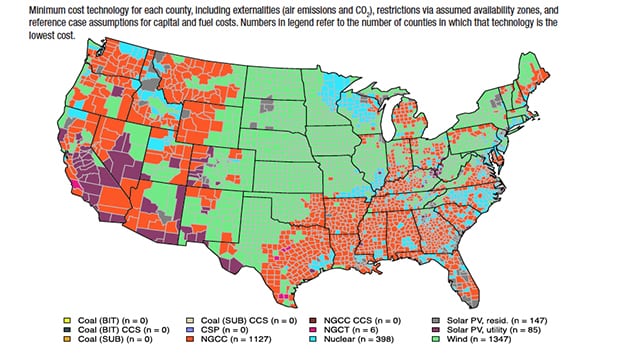Natural Gas and Wind Are Cheapest Sources of Power in Majority of U.S.
In a finding that is likely to boost controversy over the future of U.S. energy policy, a comprehensive study of the full levelized cost of energy (LCOE) from various sources of electricity conducted by the University of Texas (UT) at Austin’s Energy Institute found that wind turbines and natural gas combined cycle power plants (CCPPs) provide the least expensive options for new generation across a large majority of U.S. counties.
The study, “New U.S. Power Costs: By County, with Environmental Externalities,” is part of an ongoing initiative at UT that attempts to take a “holistic approach” to calculating both direct and indirect costs of generating electricity.
The Institute has placed the results online in the form of an interactive tool that allows comparison of the LCOE for various options and adjustment of fuel costs. (The tool also makes some assumptions about the suitability of certain generation in various locations; for example, there are areas that would be unsuitable for fossil plants for environmental reasons.)
The numbers change somewhat depending on how external costs such as carbon emissions are included. When externalities are considered and assuming an average delivered cost of gas of $5.07/MMBtu, wind was the cheapest option in a plurality of counties—1,347 out of 3,110 in the lower 48 states—most of which were concentrated in the central U.S. (Figure 1). Natural gas CCPPs came in a close second as the cheapest in 1,127 counties, while nuclear was a distant third with 398.

Without considering environmental and health impacts, natural gas was the least expensive option across about half of the country, while wind dominated the Midwest and Northeast, and utility-scale solar photovoltaic ranked third ahead of nuclear. Perhaps surprisingly, the price of gas did not make a significant difference in the balance, as lowering the price to $3/MMBtu generated relatively minor gains for gas in the central U.S. and Arizona.
Notably, coal-fired generation was not the cheapest option in any county when externalities were considered. Incoming president-elect Donald Trump has promised to revitalize the U.S. coal industry, though most experts suggest there is little he can do over the long term because of a range of macroeconomic trends that are working against coal-fired power.
—Thomas W. Overton, JD is a POWER associate editor (@thomas_overton, @POWERmagazine).